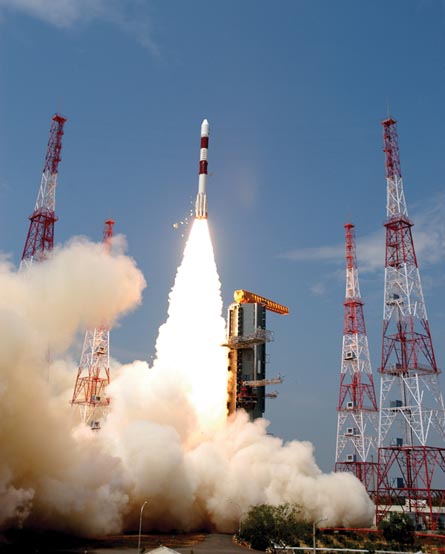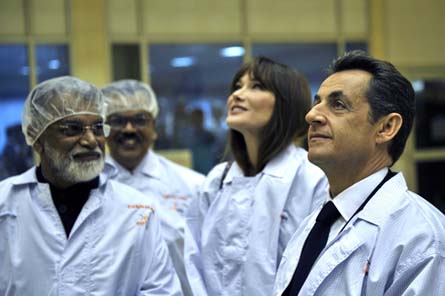India's space agency is sharpening its focus on manned spaceflight, lunar exploration and planetary probes - and is considering a Moon mission.
The Indian Space Research Organisation (ISRO) is also planning a reusable transport system to reduce the cost of access to space. The Indian space agency is also aiming for new-generation remote-sensing satellites with hyper-spectral imaging capability, and advanced communications spacecraft with higher bandwidth and wider coverage.
ISRO has denied suggestions that its manned-flight programme is a reaction to China's success in human space missions. But the view that India should not lag behind its neighbour has currency.
 |
|---|
© ISROIndia's Polar Satellite Launch Vehicle (PSLV) has launched 44 satellites so far |
For India's first manned mission - scheduled for 2016 - ISRO will set up new facilities and develop a host of technologies. A third launchpad is to be added at Sriharikota spaceport on India's eastern coast. And in a tie-up with the Institute of Aviation Medicine, ISRO plans to set up an astronaut training facility at Bangalore by 2013.
MANNED CAPSULE
After a first phase of technology development - relating, in part, to re-entry - the focus will shift to the man-rated space capsule. Russia will help India develop a manned capsule based on Soyuz technology, under an agreement signed in 2008.
India hopes to be the fourth country, after the USA, Russia and China, to send astronauts into space.
Its manned mission and plans for planetary exploration arguably represent a dilution of the Indian space programme's original philosophy. In the late 1960s, Dr Vikram Sarabhai, architect of the Indian space programme, asserted: "We do not have the fantasy of competing with the economically advanced nations in the exploration of the Moon or planets or manned flights. But... we must be second to none in the application of advanced technologies to the real problems of man and society which we find in our country."
ISRO insists it is committed to diffusing the fruits of space technology into the mainstream of national development. Two projects that are intended to be socially beneficial - the Village Resources Centre and the Telemedicine service - are based on Indian National Satellite System (INSAT) communications and Indian Remote-Sensing (IRS) earth-observation constellations operated by ISRO.
Established in 1983, INSAT is the Asia-Pacific region's largest domestic communications satellite system, involving 11 satellites. The IRS system, meanwhile, is one of the largest constellations of remote-sensing satellites in operation in the world, with 10 satellites.
Geopolitical compulsions have prodded ISRO to take up development of India's fully fledged navigation satellite constellation and end the country's dependence on global systems such as GPS Navstar. The Indian Regional Navigation Satellite System (IRNSS), comprising seven satellites, is expected to be fully operational by 2014.
As part of its "Vision 2025" strategy, ISRO plans to explore Mars, Venus and the asteroid belt. The mini research satellite Aditya will be launched in 2012, to study the solar corona. Launch of the Mars orbiter - designed to study the chemical attributes of the Martian atmosphere, and the planet's subsoil and terrain - will follow after 2015. ISRO chairman K Radhakrishnan says the organisation has been able to achieve a lot on a shoestring. The agency's budget for 2009-10 was around $1.3 billion, its highest ever.
India's first Moon mission, Chandrayaan-1, launched in 2008 to search for water on the lunar surface. The follow-on Chandrayaan-II mission, involving a lander and rover, will launch in 2013 by means of the three-stage Geosynchronous Satellite Launch Vehicle (GSLV). The aim is to collect samples of lunar soil and conduct in-situ chemical and mineralogical studies. The lander will be provided by Russia, but the orbiter and rover are being built by ISRO, says the Indian agency.
However, India continues to lag behind in boosting its launch capability. ISRO is halfway through plugging the defects in the home-grown cryogenic stage, the malfunction of which resulted in the failure of the GSLV mission in April 2010. In a setback to the ISRO, December's GSLV flight - powered by a Russian cryogenic engine - also failed.
 |
|---|
© Rex Features |
The GSLV is intended to make India self-reliant for launching communications satellites weighing up to 2.5t. ISRO was dependent on France's Arianespace for getting its INSAT communications satellites off the ground.
Radhakrishnan says the GSLV will be flown again in 2011. ISRO is also developing a heavy-lift-off GSLV Mk III capable of placing a 4t class satellite into a geostationary transfer orbit. In parallel, the agency is pursuing a technology demonstrator for a two-stage-to-orbit fully reusable space vehicle. And to support deep space missions, ISRO is developing a semi-cryogenic rocket stage fuelled by kerosene and liquid oxygen.
The four-stage Polar Satellite Launch Vehicle (PSLV) - which has alternative solid and liquid propulsion systems - is still India's space workhorse, having launched 25 foreign satellites and 19 Indian satellites so far. It has fed the success achieved by Antrix, the Indian space programme's commercial arm, in securing foreign satellite-launch contracts.
Indian industry meets about 60% of the Indian space programme's component requirements, with more than 500 small, medium and large companies contributing. But the industry has not matured sufficiently to build and deliver entire satellites and launch vehicles in a ready-to-use condition.
ISRO continues to value international co-operation as a way to boost its technological expertise and self-reliance. In December, French president Nicolas Sarkozy visited the ISRO Satellite Centre in Bangalore to review the progress of two Indo-French satellite projects to be launched this year by the PSLV.
Boeing and Lockheed Martin have held talks with ISRO for potential co-operation in India's manned flight missions. And, in recent years, Israel has emerged as a favoured ISRO partner. Its TECSAR reconnaissance satellite, featuring an all-weather microwave imaging payload, was launched by the PSLV on commercial terms in January 2008. As a quid pro quo, Israel helped ISRO build its microwave remote-sensing satellite RISAT-II, which was launched in April 2009.
ISRO also offers assistance to developing nations. In December 2009, Indian prime minister Manmohan Singh offered to make satellite resources data available to South-East Asian countries for managing natural disasters and launch support for orbiting small satellites. This was a clear attempt to expand the "soft power" of Indian space technology.
Source: Flight International






















